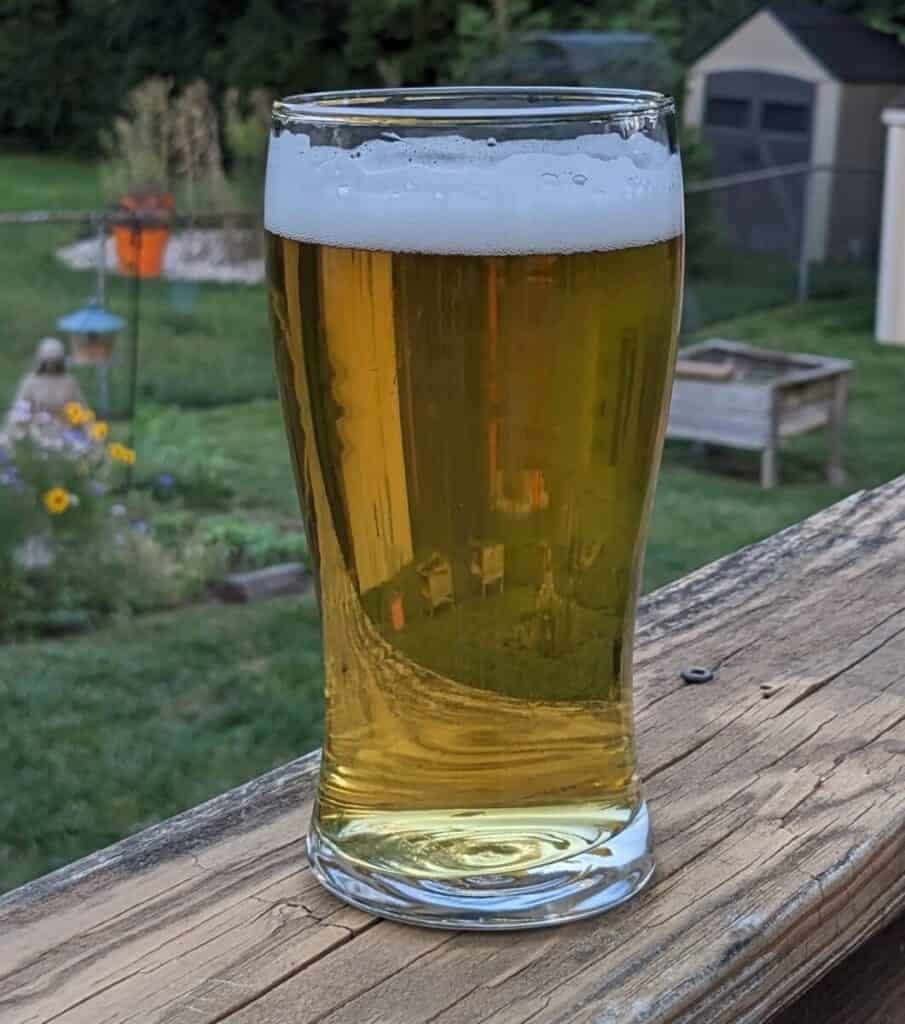What’s more refreshing on a hot summer day than a cold, crisp, German lager? One of my favorite beers is the Munich Helles and one of my favorite commercial examples of this style comes from none other than Weihenstephan in Bavaria.
What is a Munich Helles?
Helles is the German word for “bright” or “pale” and Munich Helles is just that: a light, mild, drinkable beer that is golden straw in color with rounded hop flavor and smooth, malty flavor.
“A gold-colored German lager with a smooth, malty flavor and a soft, dry finish. Subtle spicy, floral,
2021 BJCP Guidelines
or herbal hops and restrained bitterness help keep the balance malty but not sweet, which helps make this beer a refreshing, everyday drink.”
Definitely, a beer I could drink on any occasion; any time of year.
This post may contain affiliate links which means I may receive a commission for purchases you make through these links. Learn more on my Support page.
One Way to Brew Munich Helles
The BJCP guidelines list these vital statistics for a Munich Helles:
| BJCP Category | 4A |
| ABV | 4.7–5.4% |
| Original Gravity (OG) | 1.044–1.048 |
| Final Gravity (FG) | 1.006–1.012 |
| IBU | 16–22 |
| Color (EBC) | 6–10 (3–5 SRM) |
Once again pulling inspiration from David Heath, I’m using his tried-and-tested recipe, which can be found here.
Modifications
In David’s recipe, he uses an Australian Saaz-type hop called Summer. I didn’t have this particular hop, but I did have Spalter Select in my hop freezer. So, I’ve adjusted my recipe to closely match the IBUs from each addition in my recipe, which can be found here.
Munich Helles Recipe
Here’s a video from the brew day through to impressions of the beer.
Batch Vital Statistics
| Stat | Value |
|---|---|
| OG | 1.053 (1.048 Target) |
| FG | 1.011 (1.009 Target) |
| ABV | 5.5% (5.1% Target) |
| Color | 7.7 EBC |
| IBU | 20 |
| Boil Time | 30 minutes |
| Batch Volume | 21 L |
Water Profile
| Ca2+ | Mg2+ | Na+ | Cl– | SO42- | HCO3– | pH |
|---|---|---|---|---|---|---|
| 49 | 2 | 0 | 75 | 25 | 0 | 5.33 |
I added 3.8 g calcium chloride, 0.6 g magnesium sulfate, 0.7 g calcium sulfate, and 2.5 mL lactic acid to distilled water to reach the target water profile. After 10 minutes into the mash, I took an aliquot and cooled the sample to 20 °C. The pH measured 5.33.
Fermentables
| % | kg/g | lb/oz | Grain/Adjunct |
|---|---|---|---|
| 88.3% | 3.4 kg | 7.5 lb | BestMalz Pilsen Malt |
| 5.2% | 200 g | 7 oz | Weyermann Carapils |
| 4.3% | 167 g | 6 oz | Briess Vienna Malt |
| 2.2% | 84 g | 3 oz | Weyermann Melanoidin |
Mash Profile
| Step | Temperature (°C) | Temperature (°F) | Time (minutes) |
|---|---|---|---|
| Saccharification Rest | 65 | 149 | 60 |
| Mash-out | 75 | 167 | 10 |
Hops
| Hop | Alpha Acid | Time (minutes) | IBU |
|---|---|---|---|
| Spalter Select | 3.4% | 30 | 17 |
| Spalter Select | 3.4% | 5 | 3 |
Yeast
After the boil, the wort was chilled to 20 °C (68 °F) and I then used lactic acid to adjust the wort pH to 5.–. The wort was then transferred to a Kegland Fermzilla All Rounder 30L fermentor and further cooled to 15 °C.
For this recipe, I used Novalager from Lallemand.
Fermentation Profile
Fermentation temperature was maintained using a submersible pump controlled by an InkBird temperature controller that pumped ice water through a stainless steel coil (Kegland Temp Twister) in my Fermzilla All Rounder. At this time of year, my basement sits around 20–22°C (68–72 °F), so I didn’t need a heating mat to heat the fermenter.
| Step | Temperature (°C) | Temperature (°F) | Time |
|---|---|---|---|
| Initial | 15 | 59 | 3 days |
| Temperature Raise | 18 | 64 | 11 days |
| Conditioning (Lagering) | 5 | 41 | 14 days |
After 3 days of fermentation at 15–16 °C, the yeast had reached about 50% apparent attenuation, so I let the beer free-rise to 18 °C, where that temperature was maintained for the remainder of the fermentation.
Final gravity (FG) was 1.011, which gives 5.5% ABV and an attenuation of 79%.

Once final gravity was reached, the beer was transferred to a keg and cooled to 5 °C to lager for 14 days. The beer was then placed under 15 psi CO2 for 7 days to carbonate to 2.7 volumes of CO2.
Munich Helles Recipe Impressions

| Appearance | Clear, light gold. Light white head that dissipates after a few minutes. |
| Aroma | Light malt aroma, cracker. Background notes of spice and herbs. |
| Mouthfeel | Medium body, medium carbonation. |
| Flavor | Moderately sweet, grainy, cracker malt flavor. A little spiciness from the Spalter Select hops. There’s a bit of red apple coming through. This may be fermentation-related. |
Overall, a crisp, refreshing, and thirst-quenching beer. For the next time I brew a Munich Helles, I may use a different lager yeast instead of Novalager. Do you like German lagers like Munich Helles?
